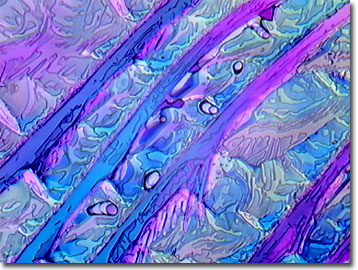Polarized Light Digital Image Gallery
Prostaglandin A1
Prostaglandins are members of the lipid class of biochemicals and are known for their potent physiological properties by regulating fat metabolism, inflammatory response, hormones, as well as the cardiovascular, immune, and central nervous systems. They belong to a subclass of lipids known as the eicosanoids, because of their structural similarities to the C-20 polyunsaturated fatty acids (the eicosaenoic acids).

Usually named by letters and numbers such as E1 and A2, prostaglandins are grouped by chemical similarity and not by physiological effect. Gamma-linoleic acid, a prostaglandin precursor, may facilitate prostaglandin metabolism in premenstrual tension, while hydrocordone bitartrate/ibuprofen, a sedative, may inhibit prostaglandin synthesis by interfering with cyclo-oxygenase activity. Recent research shows that while aspirin and other non-steroidal anti-inflammatories (NSAIDs) are usually considered conservative treatment for inflammation and pain, there may be significant side effects of inhibiting healing by interfering with the prostaglandin-growth factor pathways.
Prostaglandins act in a manner similar to that of hormones, by stimulating target cells into action. However, they differ from hormones in that they act locally, near their site of synthesis, and they are metabolized very rapidly. Another unusual feature is that the same prostaglandins act differently in different tissues. Living up to the adage you are what you eat, consuming foods rich in omega-6 fatty acids, such as meats and most vegetable oils, stimulates the production of inflammatory prostaglandins, while consuming the omega-3 fatty acids, featured in tuna and cold-water salmon, stimulates the production of anti-inflammatory prostaglandins. This might explain the long use of cod liver oil to reduce the pains of arthritis and rheumatism and gives credence to the current push by nutritionists to use flax seed, evening primrose oil, borage oil, and canola (rapeseed) oil.
First discovered in semen, prostaglandins received their name from the prostate gland, where they were first thought to originate. It has now been established that prostaglandins occur in many tissues and are not restricted to specific organs. Cramping during the menstrual cycle has been attributed to prostaglandins and this explains why NSAIDs are an effective treatment.
The highly unusual biochemical properties of the prostaglandins have attracted the interest of pharmaceutical manufacturers, and many are now commercially available. Furthermore, the pharmaceutical industry and medicinal chemists are investigating derivatives that may have enhanced biological properties.
Contributing Authors
Omar Alvarado, Thomas J. Fellers and Michael W. Davidson - National High Magnetic Field Laboratory, 1800 East Paul Dirac Dr., The Florida State University, Tallahassee, Florida, 32310.
BACK TO THE POLARIZED LIGHT IMAGE GALLERY
BACK TO THE DIGITAL IMAGE GALLERIES
Questions or comments? Send us an email.
© 1995-2025 by Michael W. Davidson and The Florida State University. All Rights Reserved. No images, graphics, software, scripts, or applets may be reproduced or used in any manner without permission from the copyright holders. Use of this website means you agree to all of the Legal Terms and Conditions set forth by the owners.
This website is maintained by our
Graphics & Web Programming Team
in collaboration with Optical Microscopy at the
National High Magnetic Field Laboratory.
Last Modification Friday, Nov 13, 2015 at 01:19 PM
Access Count Since September 17, 2002: 14168
Visit the website of our partner in introductory microscopy education:
|
|
